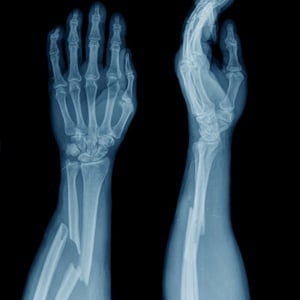
Researchers have found that an experimental technique has healed large bone breaks in lab animals, researchers have found.
The technique is still far from becoming a reality, but, it repaired large bone gaps in the mini-pigs scientists studied. The hope, the researchers say, is to eventually help people with badly broken bones that won't heal.
The results of the study were published in Science Translational Medicine.
When a bone sustains a simple fracture, it is usually able to self-repair with time (and a cast). However, severe fractures can leave large gaps in the bone that the self-healing process cannot bridge.
The aim of gene therapy
Health24 previously reported that the basic function of genes is to regulate the production of proteins required for the healthy working of cells. Thus, genetic defects manifest in either too little or too much of a protein being produced.
The aim of gene therapy is to replace the defective gene with a healthy one. The correct amount of proteins will be produced, and the disease will then be cured.
Geneticists are literally snipping defective pieces out of a strand of DNA with molecular “scissors” called CRISPR.
Bone grafting
Right now, the "gold standard" treatment for those fractures is bone grafting, said Dan Gazit, one of the senior researchers on the new study.
There, surgeons take bone tissue from elsewhere in the body – or from a donor – and use it to repair the damaged bone.
When bone grafting is done with a patient's own tissue – often taken from the pelvis – that means additional surgery. And it can leave patients with prolonged pain and added risk of infection, Gazit said.
New approach
First, the researchers implanted a matrix of collagen – a protein in bone – into the gap between the two sides of a fractured bone.
That collagen then attracted the bone's resident stem cells, and gave them a structure to settle into. Stem cells are early cells that develop into mature tissue, including bone.
Once those cells have populated the gap in the bone, the next step involves gene therapy. The researchers injected a mixture of "microbubbles" and genetic material for a bone-promoting protein, called BMP, into the injury site.
That spurred the stem cells to form new bone tissue, according to the report.
In this study, the tactic healed bone breaks in all of the lab animals the researchers treated, Gazit said. In untreated pigs, the breaks did not heal, the findings showed.
A sophisticated approach needed
"But there are problems with BMP," said Dr Joseph Lane, an orthopaedic trauma surgeon at the Hospital for Special Surgery in New York City.
A central issue, he said, is that very high BMP doses may be needed, and side effects – including infections and excess bone growth – are common.
The new approach is "going in that direction", said Lane, who was not involved in the research. The "beauty" of it, he said, is that it harnesses the bone-promoting effects of BMP in a more natural way.
A number of questions should be answered before human trials are done, according to Lane. For example, he said, future animal research should look at more complicated fractures. The bone injuries used in this study are relatively easy to heal, versus severe fractures, Lane said.
Read more:
6 lifestyle triggers for broken bones




 Publications
Publications
 Partners
Partners











